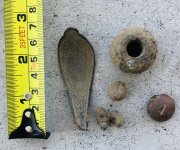49er12
Bronze Member
- Aug 22, 2013
- 1,238
- 1,627
- Detector(s) used
- Minelab xterra, Whites DFX, Notka Makro Simplex. Folks the price don’t mean everything, the question is are you willing to put in the time to learn the machine, experience will pay off I guarantee it.
- Primary Interest:
- All Treasure Hunting
May posted before sorry, being the times of 1800 up to the industrial revolution what did early settlers have of valuables, are we stupid to think especially when we detect old foundations in the woods. Silver and gold, I mean come on these folks where poor correct. You might find spoons, buttons, horseshoe, obvious relics of the times but not precious metals. Anyhow please correct me I’ve been wrong before, if silver and or gold was kept hoarded or buried near by, thankyou
Amazon Forum Fav 👍
Last edited by a moderator:
Upvote
0





